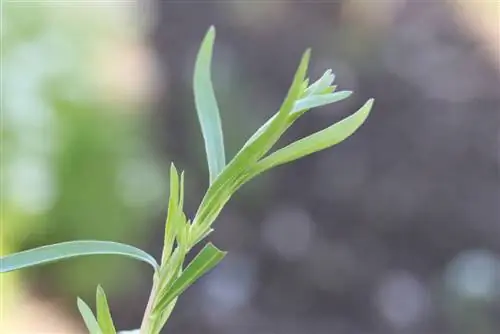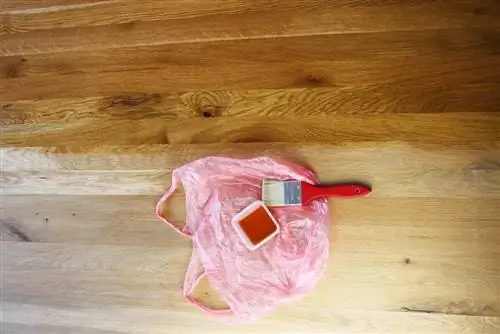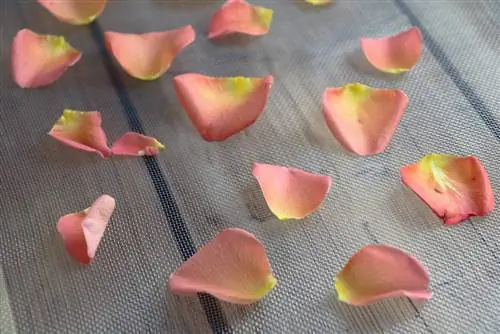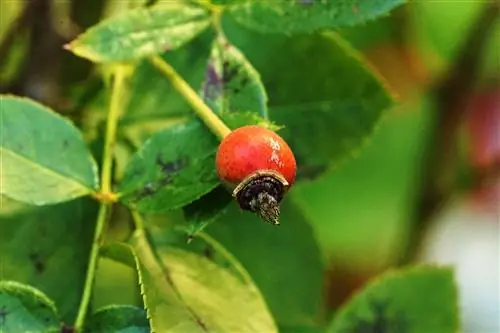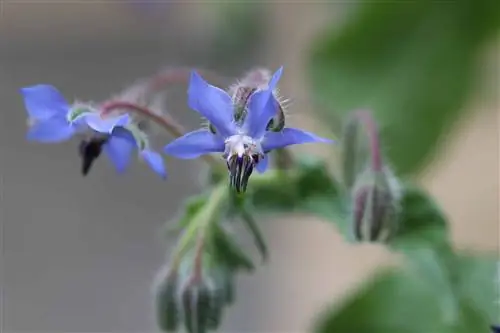- Author admin [email protected].
- Public 2023-12-17 03:39.
- Last modified 2025-01-24 12:45.
Tarragon used to be a natural part of the herb bed in the kitchen garden and was then pretty much forgotten. Only the top gastronomy has never forgotten the delicious tarragon, thankfully, so it can now conquer our kitchens again together with the “original recipe from the top chef”. As a result, it conquers the herb garden again - before it is planted, however, the gardener should know that this herb comes in two very different appearances:
Tarragon profile
- Tarragon belongs to the plant family Asteraceae and within this genus Artemisia, such as wormwood, mugwort and boar rue
- The herb scientifically named “Artemisia dracunculus” was formerly known colloquially as Bertram, Dragon, Eggwort, Imperial Lettuce and Zitwerkraut
- Suggests that our ancestors still knew their kitchen spices
- With the advent of fast food and ready meals, tarragon was forgotten for quite a long time
- It is being rediscovered since people are cooking more in Germany
- Russian tarragon is the most sold for beds, a robust herb but rather disappointing in taste
- Only French tarragon has the famous fine aroma
- Which cannot be grown from seeds and is difficult to find even as a young plant
- Once the tarragon is in the garden bed, caring for it is unproblematic
Against confusion: Why there are two real tarragon
Tarragon is a perennial herb with actually very characteristic narrow, pointed leaves that grow slightly “untidy” and barely branched, close together on individual shoots. These vertical shoots are also close together and form dense green areas.
The tricky thing is that there are several different tarragons with and without spice, including two “real tarragons”, so first a little order has to be brought into the tarragon confusion:
Real Russian (or Siberian) Tarragon
Tarragon originally developed in the colder regions of Russia, from there it reached Arabia and Europe with the first traveling spice traders a long time ago (and from there it spread further, today tarragon is known in most parts of the World, it is widely used in both America and India).
The biologically “real tarragon” is the Russian or Siberian tarragon with the botanical name Artemisia dracunculus var. inodora. This identification as a variety is an indication that it is no longer the true wild form, but rather the first tarragon improved through breeding.
You can get this tarragon if you simply ask for “tarragon” or “tarragon seeds”. It tolerates our climate up to the last extreme cold, forms seeds easily in contrast to the other variations of the species and cuts a pretty good figure with its fairly wide leaves that shimmer silver on the underside on strong shoots. This tarragon is very easy to grow and is therefore the most widely grown by nurseries / for trade and therefore the most sold.
Real French Tarragon
At the French court, tarragon underwent probably the most dramatic transformation. It was further refined by French gardeners through breeding into the French tarragon Artemisia dracunculus var. sativa with a delicate, sweet aroma reminiscent of aniseed. In this variant it has made a career in classic French cuisine. When it comes to gastronomic matters, French tarragon is the “real tarragon”.
Artemisia dracunculus var. sativa forms more delicate, longer, narrower leaves than the Russian tarragon, which are grouped slightly scattered around the upright shoot, but contain up to three percent essential oil - compared to the Russian tarragon with around 0. 1 percent essential oil creates a much more intense aroma.
The small disadvantage of this breeding variant is that it hardly produces any flowers or seeds and can therefore only be propagated vegetatively. Compared to simply sowing it is a laborious business, which is why French tarragon is only produced and offered by a few specialist herb nurseries.
Tip:
You may also come across a German tarragon at your herbalist. Also only as a young plant because it is sterile, not very often because it is as bitchy as the Frenchman, but occasionally. Take it, try it out, it's not all that bitchy, but its strong aroma should make you feel a lot of French lightness alongside Russian heaviness. If you come across other varieties of tarragon, in the garden center, on the side of the road, here or in a southern European country - it's best to just taste it and sense a possible aroma for yourself; If there is a seller, you could perhaps ask them which ancestor (Russian, French) this tarragon can be traced back to.
Cultivation
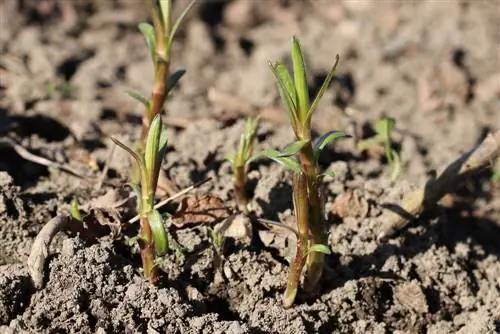
The two fundamentally different main varieties of tarragon are also grown fundamentally differently:
Sowing and caring for Russian tarragon
As soon as you hold tarragon seeds in your hand, you are definitely dealing with Russian tarragon, it is the only seed-producing cultivar.
Pre-breeding is possible, depending on the region, from mid-March and the end of April. Almost everywhere in Germany, a pre-breeding start in mid-April produces young plants that can be planted in good time. The seed trays are filled with nutrient-poor growing substrate, the light germinator is scattered and lightly pressed into the substrate; the best germination temperatures are between 18 and 25 °C. The seed tray with tarragon does not need to be covered, but the seeds must be kept moist throughout because the seedlings cannot tolerate drought.
Depending on the germination temperature, the tarragon needs 7 - 14 days to germinate. The pre-culture is pricked out in the garden bed at the time when the tarragon can be sown directly into the garden:
The germination temperatures just mentioned also apply to direct sowing; in most regions of Germany the soil is warm enough at the beginning of May. The Russian tarragon will please you in terms of its location requirements; it makes do with a corner of the garden where not many plants otherwise feel comfortable: it gets along with poor soil and even develops better in it than in more nutrient-rich soil. It doesn't need more light than partial shade, it shouldn't get more light: If Russian tarragon grows in the sun and it's hot and dry in summer, it quickly develops bitter substances, the taste of which is unpleasant for most people.
This robust tarragon can grow in the same place for years, even with reseeding and rejuvenation, which should promote the development of the full aroma. When the seedlings stick their heads out into the light, they are allowed to grow for a few days until you can notice any developmental differences. Then it is thinned out, only the strongest seedlings remain and should, if possible, have 50 x 50 cm to themselves. Sounds like a lot, but it doesn't mean more than that the distance to the next tarragon plant is 25 cm. This is the distance at which the tarragon grows together most quickly into a “closed union” in which the plants support each other in growing.
If early tarragon plants (which are often available to buy in spring) have been planted in the bed or directly sown tarragon has developed into a young plant, you only have to do some work caring for the Russian tarragon if you do it have to prevent it from taking over the neighboring bed with its rhizomes.
Tip:
What you just read was the most popular version of the “Russian Tarragon Growing Guide”. There are experienced herb gardeners who handle the sowing time differently: They sow the Russian tarragon directly outdoors in early spring because they want a little bit of cold to affect the seeds. If you consider the second name of the Russian tarragon (Siberian tarragon), this seems to be a pretty good idea, every plant develops the most aroma when the conditions of its original home are as close as possible.
Planting French Tarragon
If you have found the above-mentioned herb specialist nursery with French tarragon (you were looking for it because you love real Bearnaise sauce, which is also usually available in a bag in restaurants today), you are sure to have a few young French tarragon plants too Purchased tarragon.
In contrast to their robust relatives, these delicate plants have a few requirements:
- Don't go shopping too early, French tarragon is sensitive to frost
- In such endangered areas, only plant after the Ice Saints
- Location: sunny, warm, sheltered from the wind, moist, nutrient-rich
- Plant 50 to 60 cm apart
- Keep all competitors (weeds) away from young plants
- Always keep moist
- Never expose to waterlogging
- For full flavor, give natural fertilizer in the main growth phase (which you are sure will not affect the taste)
- If growth is good, support with stakes
- Condense the foliage by regularly thinning out the stems
- Treat flower bases as described below under “harvesting and preserving”
- Apply winter protection in very cold winters
- Do not cultivate in the same location for a long time
Once the French tarragon has accepted a location, it usually grows happily, and in the season after next it even withstands the sudden nasty frost. It's actually a shame that the time is approaching to think about the next location for "Monsieur".
Harvesting and preserving
A few weeks after planting, the tarragon is ready to harvest, depending on when the tarragon was placed in the bed, between mid-May and the end of June. It should then be harvested because then it is close to flowering; For tarragon, the optimal harvest time is when it has the most aroma.
During the flowering period, the aroma would then migrate into the flower, the foliage (herb) itself would noticeably lose its flavor. How you deal with this depends on whether you prefer to harvest a particular type of spice all at once and preserve everything together for the rest of the year (even if that means a little loss of flavor) or whether you prefer to keep your various herbs for as long as possible Harvest fresh from the bed as needed.

The first case, harvesting and preserving, allows several variants of preservation:
- Harvesting tarragon
- Here only the leaves, without branches
- You can cut whole branches when harvesting
- These should then be removed as soon as possible
- Also applies to drying, tarragon is not hung on the branch
- Leaf and branch exchange cell fluids after harvesting
- With tarragon, the twigs only contribute tart and bitter flavors
- The contents of the leaves migrate into the branch (and not into the cooking pot)
- The shoot tips are exempt from this rule
- As long as they are soft and flexible, they can be used whole
- As much tarragon as possible should be used fresh
- The leaves stay fresh for a while in a plastic bag in the fridge
- The next batch is frozen in the ice cube tray with a little water
- If tarragon is needed, a cube is taken
- Tarragon can be preserved in white wine vinegar, oil, mustard
- But should be used in this form until next season
Only at the very end does the drying take place, which of course also works with tarragon, but is associated with a considerable loss of quality in terms of aroma. Nevertheless: Even if the flavor of dried tarragon cannot be compared to that of fresh tarragon, typical tarragon dishes still taste better with dried tarragon than without.
In the second case, harvest as much as possible freshly and for a long time, proceed as follows:
- Observe inflorescences from the beginning of development
- Buds are ok, if they swell too
- As soon as the first yellow petal peeks out, the inflorescence is cut away
- Now you can harvest tarragon leaves and use them fresh until the first frost
- Or whole, tender shoot tips, always cutting off half the shoot
- Remove the seasoning shoot tips and leaves, discard the hard remaining piece of branch
- This means that new, tender side shoots will form until shortly before the end of the season
Tip:
Before a larger tarragon harvest, it is worth doing some preparation to harvest maximum aroma content: plan for the best weather to be expected within the next 10 days. On day 1, the tarragon receives a gentle, thorough cleaning shower with a fine spray jet at dusk. On day 2 (when the sun will hopefully be shining), cut off all the whole stems in the late morning. At this time the sunshine has ensured maximum aroma enrichment in the leaves; As soon as the midday sun begins to set, the aroma degradation begins. All branches are collected in a heap on a work table, where you sit down immediately after cutting to strip all the leaves from the stem. There are flat containers next to the work table on which the leaves are spread out to dry.

